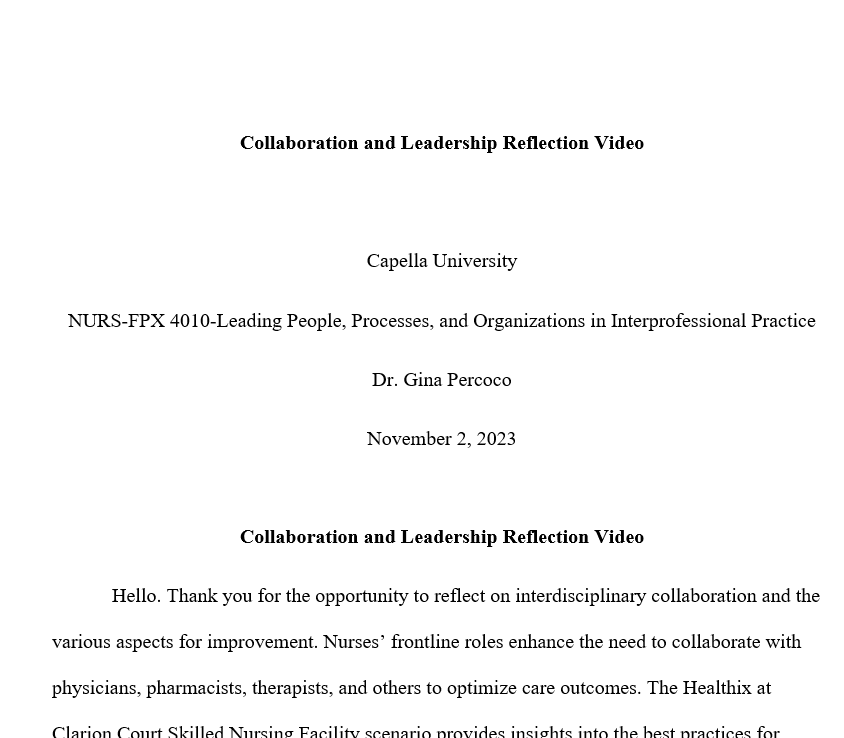Interdisciplinary Plan Proposal
Capella University
NURS-FPX4010: Leading People, Processes, and Organizations in Interprofessional Practice
Dr. Khaliah Fisher-Grace
January 31, 2023
Interdisciplinary Plan Proposal
Staff burnout is among the challenges facing healthcare providers. The issue negatively impact the quality, safety, and cost of patient care due to the risk of increasing nurse turnover rates. Interdisciplinary collaboration is among the viable strategies that protect nurses from turnover intentions, burnout, and reduce morale (Rosenberg, 2019). With the high number of patients seeking services for multiple conditions, organizations can benefit from interdisciplinary rounds, where nurses, pharmacists, physicians, and other members of a medical team collaborate and coordinate efforts to optimize care outcomes.
Objectives
- To engage the audience on the value of team efforts in reducing staff burnout. The objective highlights the need for healthcare professionals to adopt interpersonal values, behaviors, and attitude to achieve the best outcomes (Backhouse & Ogunlayi, 2020).
- To encourage strong interpersonal communication as a means of reducing staff burnout. Excellent communication among nurses and physicians in critical care settings enhance teamwork and make healthcare professionals more responsive to patients’ needs and expectations (Duffy et al., 2020).
- To inform the audience about the value of excellent information flow across the care continuum. The approach makes members of the care team responsive to colleagues’ call for help. The objectives highlight the need for healthcare professionals, largely nurses and physicians to embrace values, behaviors, and attitudes that allow them to function well in an interdisciplinary network.
Questions and Predictions
- How will the plan influence team efforts within the critical care setting. The plan provides opportunities for nurses and physicians to identify values, behaviors, and attitudes that allow them to function well in a diverse environment.
- How will interpersonal communication reduce staff burnout? The prediction is that the different healthcare professionals will appreciate calls for positive interpersonal relations as a practice that allows them to respond collectively to issues within the critical care unit.
- How will the plan improve information flow across the critical care unit? The prediction is that different healthcare professionals will acquire knowledge and skills on effective and efficient sharing of information on events within the clinical environment. With excellent information flow, the care team responds to scenarios that require collaborative approaches.
Change Theories and Leadership Strategies
The Plan-Do-Study-Act model is appropriate for encouraging interdisciplinary practices. The framework provides four stages that guides leaders and the rest of the workforce on systematic action steps for carrying out a change (McGowan & Reid, 2018). The leader will guide the team on the goals and intended outcomes. The transformational leader clarifies what the organization seeks to accomplish, how to determine improvements, and the changes necessary to achieve the best results (Clausen et al., 2019). The initial step is to assemble the team with knowledge of the issue and opportunity for improvement (McGowan & Reid, 2018).
The transformational leader clarifies roles, timelines, and responsibility for delivering the desired results. A clear aim statement enables the audience to understand the context and process for addressing the problem. The PDSA model also guides the care team to implement an action plan on reducing staff burnout through interdisciplinary rounds. McNicholas et al. (2019) indicated that the framework involves documenting observations to ascertain the relevance of the intervention in enhancing the quality, safety, and cost of patient care. The transformational leader engages the team in studying process to ascertain improvement and viability of interdisciplinary rounds within the critical care unit. Lastly, the leader guides the team in reflecting on the plan and outcomes. The people-centered approach to leadership enables the leader to encourage collective buy-in. This way, everyone believes in the success of the intervention.
Collaboration Strategies
The team has nurses, physicians, the nurse manager, clinical assistants, and a nurse educator. A key strategy is embracing excellent communication to enable everyone to share suggestions, experiences, and knowledge on using interdisciplinary rounds to prevent staff burnout. Effective leadership is also important to strengthen interpersonal relations and maintain team cohesion throughout the change process (Schot et al., 2020). The leader creates an open, transparent, and honest environment to enable everyone to understand the purpose and implications of change. Further, the leader encourages mutual conversations to align everyone’s interests with objectives of the plan.
Organization Resources
Successful implementation of the plan depends on adequacy of resources. The organization will utilize available resources to make significant progress towards educating the care team on the relevance of interdisciplinary rounds within the critical care unit. The resources include supplied notes on shared practices and decision-making, a nurse educator, training scripts, and video sessions for in-depth understanding of interdisciplinary rounds.
Table 1
Resources
| Item | Description | Cost ($) |
| Supplied notes on interdisciplinary rounds | The notes make the audience familiar with interdisciplinary rounds, relevance, and best practices for using the intervention to reduce staff burnout | 200 |
| Nurse educator | Share knowledge and experience on using interdisciplinary rounds to improve collaboration and care coordination across the continuum. | 1,500 |
| Scripts to guide the team when performing role plays. | Role play scripts provide action steps for the audience to acquire practical knowledge and skills in using interdisciplinary rounds to share roles and overcome burnout. | 200 |
| Video sessions | A video session makes the training interesting. The audience visualizes the different collaborative practices that help prevent staff burnout. | 500 |
References
Backhouse, A., & Ogunlayi, F. (2020). Quality improvement into practice. BMJ: British Medical Journal, 368. https://www.bmj.com/content/368/bmj.m865
Clausen, C., Emed, J., Frunchak, V., Purden, M., & Sol Bruno, F. (2019). Toward resilient nurse leaders: The leadership-in-action program in nursing (LEAP-IN). Nursing Leadership (1910-622X), 32(3), 40–56. https://pubmed.ncbi.nlm.nih.gov/31714206/
Duffy, J. R., Culp, S., Marchessault, P., & Olmsted, K. (2020). Longitudinal comparison of hospital nurses’ values, knowledge, and implementation of evidence-based practice. The Journal of Continuing Education in Nursing, 51(5), 209-214. https://pubmed.ncbi.nlm.nih.gov/32347957/
McGowan, M., & Reid, B. (2018). Using the Plan, Do, Study, Act cycle to enhance a patient feedback system for older adults. British Journal of Nursing, 27(16), 936–941. https://pubmed.ncbi.nlm.nih.gov/30187794/
McNicholas, C., Lennox, L., Woodcock, T., Bell, D., & Reed, J. E. (2019). Evolving quality improvement support strategies to improve plan–do–study–act cycle fidelity: A retrospective mixed-methods study. BMJ Quality & Safety, 28(5), 356-365. https://pubmed.ncbi.nlm.nih.gov/30886118/
Rosenberg, K. (2019). RN shortages negatively impact patient safety. American Journal of Nursing, 119(3), 51. https://pubmed.ncbi.nlm.nih.gov/30801322/
Schot, E., Tummers, L., & Noordegraaf, M. (2020). Working on working together: A systematic review on how healthcare professionals contribute to interprofessional collaboration. Journal of Interprofessional Care, 34(3), 332-342. https://pubmed.ncbi.nlm.nih.gov/31329469/

